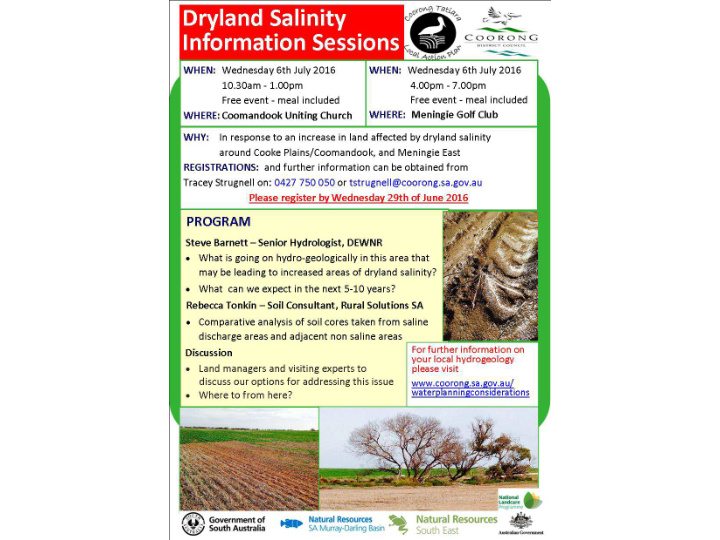



PROGRAM: DRYLAND SALINITY INFORMATION SESSION MENINGIE Samantha Blight – Coorong Tatiara Local Action Plan 10 minutes Brief History, and recent changes Steve Barnett – Senior Hydrologist, DEWNR 25 minutes What is going on hydro-geologically in this area that may be leading to increased areas of dryland salinity? What can we expect in the next 5-10 years? Rebecca Tonkin – Soil Consultant, Rural Solutions SA 40 minutes Comparative analysis of soil cores taken from saline discharge areas and adjacent non saline areas
DISCUSSION: What do you think is happening? What has not worked in past? What has worked in the past? Is there anything new? Where to from here? What can the various organisations offer?
A BRIEF HISTORY: • Some dryland salinity has always been present in this region, where the unconfined aquifer meets the surface. • Following the 1956 floods there was a marked increase in the area of dryland salinity – post barrages. • The expansion of the area of dryland salinity caused concern in the 1980’s. • This was exacerbated by the decimation of dryland lucerne by the lucerne aphid, leading to increased recharge. • Landholders, the Coorong & Districts Soil Conservation Board, Meningie Council, and State Government agencies became active in the area of addressing dryland salinity.
• In 1997 the Coorong Local Action Plan was produced with a strong emphasis on addressing dryland salinity. This was produced as a strong partnership between landholders, Council, and State and Commonwealth Government. • At the same time financial incentives funded by the State and Commonwealth Governments were released through the Coorong Local Action Plan focussing on establishing perennial vegetation across the landscape. 1997 – 2014. • Programs of this type still continue through the Coorong Tatiara Local Action Plan albeit now with a focus on Biodiversity.
• A wide range of work was carried out around this time looking at salt tolerant plants, plant water use, production of fact sheets, and regional hydro-geological plans. • There was a large degree of local landholder action eg. the Coomandook Ag Bureau established their own piezometer network, purchased a tree planter……… • Ongoing piezometer monitoring is still carried out by DEWNR. Accessed through the Water Connect website.
• Currently dryland salinity is not regarded as a high State or Commonwealth land management priority. • There is a wealth of local landholder experience in dealing with dryland salinity on ground. • LOTS of trial results, fact sheets etc we can access. • There are quite a few technical people with an interest, and experience in salinity here today…..
September 2014
August 2012
August 2012
Recommend
More recommend